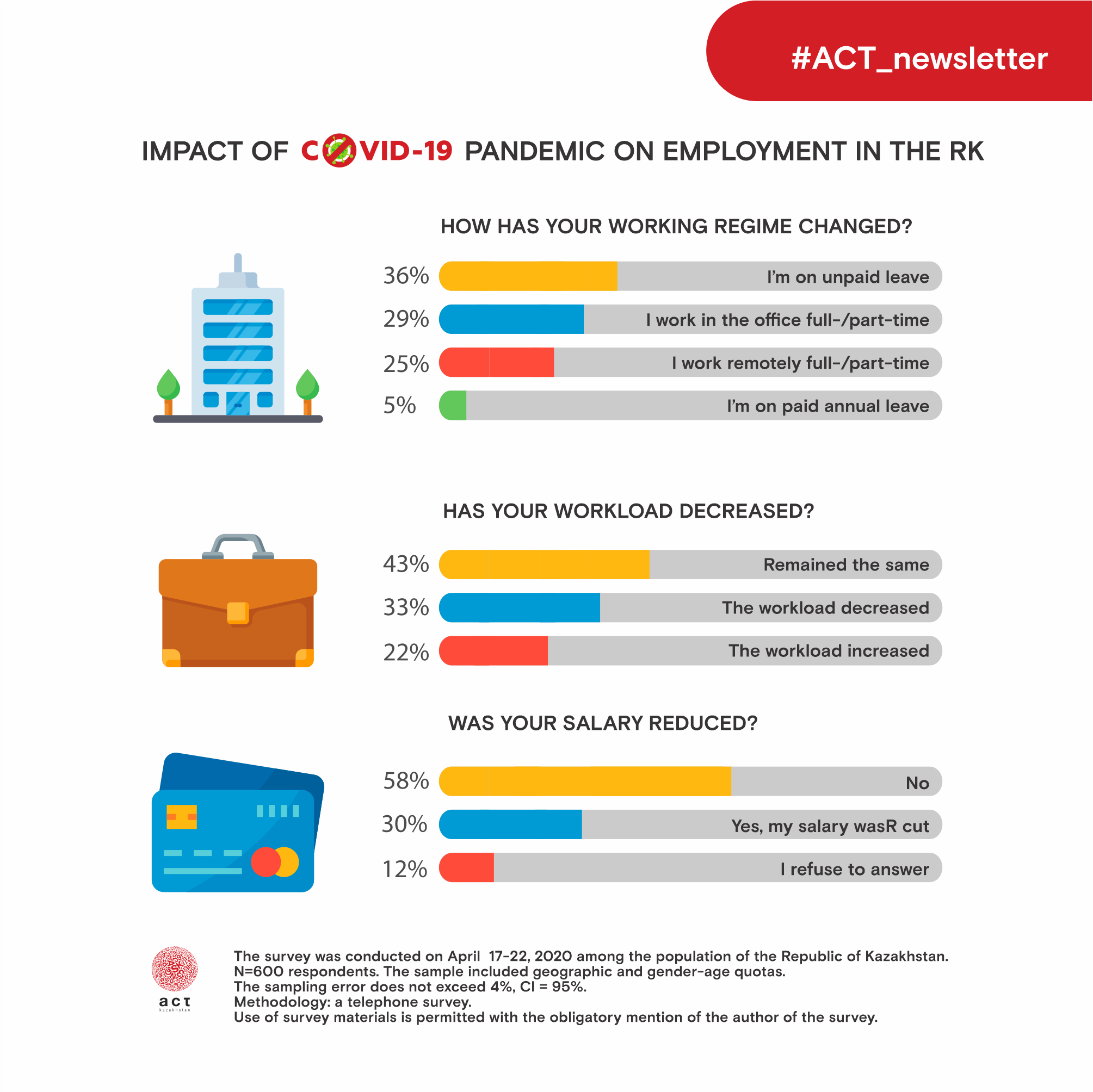




COVID-19 was the reason for introducing the unprecedented quarantine measures in modern Kazakhstan to contain the spread of the disease. In general, Kazakhstan has not introduced such large-scale quarantines over the past 50 years. The first economic forecasts related to the consequences of the introduced quarantine measures have appeared since the very beginning of the quarantine measures in Kazakhstan and other countries of the world.
During the state of emergency, ACT Kazakhstan has conducted a survey among the population of the Republic of Kazakhstan on the impact of the introduced regime on the work activities. It is worth noting that before the emergency, 79% of the respondents had a permanent job, 7% had part-time employment, and 14% of the respondents were unemployed. At the time of the survey, 36% of respondents who had a full-time or part-time job were on unpaid leave, 29% continued to work in the office (21% – full-time, 8% – part-time), 25% worked remotely, and 5% were on paid annual leave.
Regarding the workload of those Kazakhstanis who continued working online and offline during the emergency, the workload remained the same for 43% of the respondents, increased for 22% of the respondents(in particular, it affected medical workers – 18%)), and decreased for 33% of the respondents (mainly, for those involved in trade – 20% and services – 18 %). Most of the respondents have not experienced material damage from the measures introduced, and their wages remain the same (58%). Almost a third of the respondents (30%) who had a job before the emergency noted a reduction in the wage (in 11% of cases, it went down to 1 minimum wage). 12% refused to share information on changes in wages.
The reduction of wages of affected Kazakhstanis amounted to:
What are the expectations of Kazakhstanis in terms of employment? 53% of respondents expect no changes, 10% expect to be sent on unpaid leave, 5% expect to be sent on paid leave, 4% expect a reduction in wages, 2% expect to lose the job. Everyone perceives self-isolation differently. Most of the employed respondents (79%) are ready to work even in a pandemic, while 16% would not go to work even if the quarantine removed.

During the quarantine, one could come across many recommendations from specialists, psychologists, coaches, opinion leaders, and ordinary people on how to cope with stress and fears brought by the COVID-19 pandemic.In that information flow, we paid attention to a very interesting infographic (https://clck.ru/NCBxg ) by Robert L. Leahy, Doctor of Psychology. This infographic is convenient for self-diagnostics. It will help you to see which sphere you are in: the sphere of fear, education, or growth! This scheme also supports tracking the movement from one sphere to another, depending on various internal and external circumstances.
Our curiosity turned into interest. Who we, the Kazakhstanis, are during COVID-19? We’ve transformed the scheme into a question with possible variants of answers, adapted it to a data collection methodology, and asked Kazakhstanis the following question: “How yould you describe your style of behaviour during the COVID-19 pandemic? Choose one variant of the answer which provides the closest description of your behavior in the current conditions.”
The results should be reviewed in the context of a certain time period of collecting data, since, as we mentioned before, a person can move from one sphere to another.According to our measurements, on 17-22 April 2020, most of the Kazakhstanis (45%) were in the sphere of education, 43% tended for the behavior typical for the sphere of growth, 8% have found themselves in the sphere of fear, and 4% found it difficult to answer.

Back in March 2020, we started discussing with our constant client conducting an in-hall test of soft drinks. The primary purpose was to test the tastes and properties of the drinks with existing and updated formulation to assess the potential for a market launch of a refreshed soft drink. The project involved tight timing for the very test stage – the second decade of April 2020. The emergency was not declared yet at that moment, but we had a feeling that the respondents became all less and less accessible for a personal interview. Then we started thinking about possible variants in the case the emergency was declared, and quarantine introduced.
Since it has actually happened, our wish to modify our procedures just strengthened. From the first day of the quarantine, we have already been working remotely in terms of conducting telephone surveys (you can read about this here: https://clck.ru/Mq9Fu ). It only gave us confidence that anything was possible, and we might propose a product with a known methodology in a refreshed format! Here, we should emphasize the interest, involvement, and desire to help us on the part of our client. We are immensely grateful to him for his trust and challenge that led to a fruitful result for both parties, Group brainstorming helped us analyze all the possible subtleties of the methodology that we planned to translate into an online format, as well as to identify potential difficulties and draw up a detailed work plan. The most struggling issue was ensuring personal safety and compliance with the recommended sanitary measures by all project participants (ACT employees and respondents). The following stages were implemented, keeping in mind the safety and compliance aspects.
Preparation of guidance materials:
Details about recruiting of respondents:
Online-purchase/delivery of products for conducting the in-hall test:
Technical support:
The sample size was 100 respondents. The data was collected on April 10-13, 2020. The obtained experience of conducting an in-hall test during quarantine allowed us to improve and hone all the workflows necessary to conduct this kind of research. We will be glad to assist you in doing marketing research during quarantine, as well as any other time!